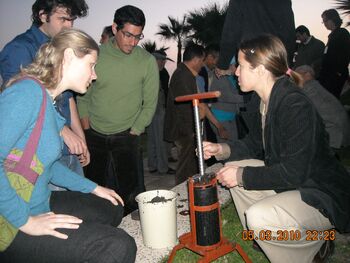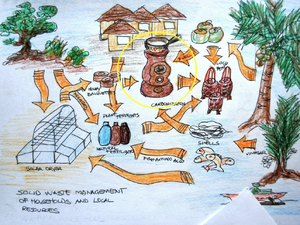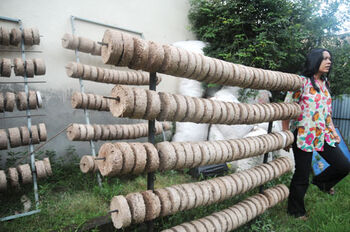mNo edit summary |
Tom Sponheim (talk | contribs) m (Reverted edits by 41.190.12.139 (talk | block) to last version by Paul Hedrick) |
||
| (31 intermediate revisions by 5 users not shown) | |||
| Line 1: | Line 1: | ||
| + | {{GoogleTranslateLinks}} |
||
| ⚫ | |||
| + | {{Updated|12|11|14}} |
||
| ⚫ | A kilo of briquettes costs Rs. 16 (20 cents US) and a kg and half will take care of a day’s cooking for a family size of four,” Shrestha Arpan says, who just got back from training disadvantaged communities in Bajura, Humla & Jumla (Nepal) about this indigenous technology. “If we could take this technology to a larger scale, imagine what 600 tonnes of daily valley waste could be transformed into – 70 per cent of the waste could be utilized to make briquettes while the rest 30 could be used to manufacture compost |
||
| + | [[File:Biomass_briquettes.jpg|right|350px]] |
||
| + | [[File:Briquette_press_2010.jpg|thumb|350px|Briquette press being demonstrated at [[Cyprus]] conference in 2010]] |
||
| ⚫ | Collect any type of waste from you home or office including paper, cardboard boxes, saw dust, scrap wood, rice husk, fruit wastes, grass, leaves, kitchen wastes, agriculture and forest residues or industrial wastes. Shred ’em, cut ’em, soak ’em and hammer ’em and what you get is a pulp. A stinking good chunk of pulp. Now press the pulp, dry it for two to three days and what you have is your briquette, all ready to burn in a range of stoves ranging from mud stove with one burner to rocket stove and room chimneys. It is energy efficient, cost-effective, manages waste and moreover an inexpensive alternate source of energy that can fuel simple households to business houses. |
||
| ⚫ | A kilo of briquettes costs Rs. 16 (20 cents US) and a kg and half will take care of a day’s cooking for a family size of four,” Shrestha Arpan says, who just got back from training disadvantaged communities in Bajura, Humla & Jumla (Nepal) about this indigenous technology. “If we could take this technology to a larger scale, imagine what 600 tonnes of daily valley waste could be transformed into – 70 per cent of the waste could be utilized to make briquettes while the rest 30 could be used to manufacture compost.” |
||
| ⚫ | |||
| + | |||
| ⚫ | |||
| + | ==Honeycomb biomass briquettes== |
||
| + | [[File:Honeycomb_biomass_briquette.jpg|thumb|200px|Beehive briquettes and the briquettes mould (ICIMOD, 2009)]] |
||
| + | Briquettes make use of compacted agricultural wastes, including fallen dry leaves, for fuel. Beehive briquettes (a honeycomb beehive-shaped biomass briquette) are made using a hand mould. The air channels help the briquette burn more easily. |
||
| + | ==Audio and video== |
||
| + | [[File:Fuego del Sol Biomass Fuel Briquette Production '13-0|thumb|none|400 px]] |
||
| + | [[File:Small (Micro) Biomass Fuel Briquette Presses made from Wood|thumb|400px|none|Learn to make a small biomass briquette press with Lee Hite.]] |
||
| + | |||
| + | ==Recent news and developments== |
||
| + | [[File:Joshua_Guinto_solar_dryer,_bio-char_diagram,_12-11-14.png|thumb|300px|Diagram showing the role the [[solar dryer]] plays in helping produce dried fruits, vegetables, and [[Biomass briquette|briquettes]] for [[fuel-efficient cookstove]]s.]] |
||
| + | *'''December 2014:''' [[Joshua Guinto]], a specialist with [[Appropriate Technologies]] has provided an update on recovery developments in the [[Philippines]] in the wake of typhoon Haiyan. Their focus has been providing [[solar dryer]]s to dry fruits and vegetables, as wells to dry wood for bio-char and [[Biomass briquette|briquette]] production for use in [[fuel-efficient cookstove]]s. Read more at: [[Media:Guinto_Appprotech_Episode_of_Reconstruction_EAST_SAMAR_Nov_2014.pdf|The Approtech Training for Salcedo Eastern Samar]] - ''[[Joshua Guinto]], November 2014'' |
||
| + | |||
| + | ==Reports== |
||
| + | *'''January 2013:''' [[Media:Solar Cooking with Integrated Systems-FOST-2011.pdf|Solar Cooking with Integrated Systems]] - ''[[FOST]]'' |
||
| + | |||
| + | ==External links== |
||
| + | *[http://home.fuse.net/engineering/ewb_project.htm Open Source DIY Biomass Briquette Technology Design and Formulations] |
||
| + | *[https://www.engineeringforchange.org/news/2010/04/14/fuel_briquettes_put_energy_in_the_peoples_hands.html Fuel Briquettes Put Energy in the Peoples’ Hands] - ''Engineering for Change'' |
||
| + | *[http://www.pciaonline.org/bulletin/pcia-bulletin-issue-29 Partnership for Clean Indoor Air (PCIA) Bulletin #29] The issue focuses on the fuel side of the improved stoves equation, with an in depth discussion of charcoal and briquettes. |
||
| + | *[http://www.briquettebiomass.com/ Biomass Briquette Maa Kamla Santosh Biomass Fuel Industry India] |
||
| + | *[http://assets.helvetas.org/downloads/sys5_alternative_energy.pdf HELVETAS Swiss Intercooperation document containing information about their biomass briquette work] |
||
==See also== |
==See also== |
||
*[[Foundation for Sustainable Technologies]] (FoST) |
*[[Foundation for Sustainable Technologies]] (FoST) |
||
| + | *[[El Fuego del Sol]] |
||
| + | *[[Rocket Stove]] |
||
| + | *[[Partnership for Clean Indoor Air]] |
||
| + | |||
| + | {{InterwikiLink|Briquettes de biomasse}} |
||
[[Category:Nepal]] |
[[Category:Nepal]] |
||
Revision as of 04:15, 21 May 2015
|
Last edited: 11 December 2014
|

Briquette press being demonstrated at Cyprus conference in 2010
Collect any type of waste from you home or office including paper, cardboard boxes, saw dust, scrap wood, rice husk, fruit wastes, grass, leaves, kitchen wastes, agriculture and forest residues or industrial wastes. Shred ’em, cut ’em, soak ’em and hammer ’em and what you get is a pulp. A stinking good chunk of pulp. Now press the pulp, dry it for two to three days and what you have is your briquette, all ready to burn in a range of stoves ranging from mud stove with one burner to rocket stove and room chimneys. It is energy efficient, cost-effective, manages waste and moreover an inexpensive alternate source of energy that can fuel simple households to business houses.
A kilo of briquettes costs Rs. 16 (20 cents US) and a kg and half will take care of a day’s cooking for a family size of four,” Shrestha Arpan says, who just got back from training disadvantaged communities in Bajura, Humla & Jumla (Nepal) about this indigenous technology. “If we could take this technology to a larger scale, imagine what 600 tonnes of daily valley waste could be transformed into – 70 per cent of the waste could be utilized to make briquettes while the rest 30 could be used to manufacture compost.”
[Excerpt from The Himalayan Beacon website, Sept. 4, 2009.]
Honeycomb biomass briquettes

Beehive briquettes and the briquettes mould (ICIMOD, 2009)
Briquettes make use of compacted agricultural wastes, including fallen dry leaves, for fuel. Beehive briquettes (a honeycomb beehive-shaped biomass briquette) are made using a hand mould. The air channels help the briquette burn more easily.
Audio and video

Fuego del Sol Biomass Fuel Briquette Production '13-0

Small (Micro) Biomass Fuel Briquette Presses made from Wood
Learn to make a small biomass briquette press with Lee Hite.
Recent news and developments

Diagram showing the role the solar dryer plays in helping produce dried fruits, vegetables, and briquettes for fuel-efficient cookstoves.
- December 2014: Joshua Guinto, a specialist with Appropriate Technologies has provided an update on recovery developments in the Philippines in the wake of typhoon Haiyan. Their focus has been providing solar dryers to dry fruits and vegetables, as wells to dry wood for bio-char and briquette production for use in fuel-efficient cookstoves. Read more at: The Approtech Training for Salcedo Eastern Samar - Joshua Guinto, November 2014
Reports
- January 2013: Solar Cooking with Integrated Systems - FOST
External links
- Open Source DIY Biomass Briquette Technology Design and Formulations
- Fuel Briquettes Put Energy in the Peoples’ Hands - Engineering for Change
- Partnership for Clean Indoor Air (PCIA) Bulletin #29 The issue focuses on the fuel side of the improved stoves equation, with an in depth discussion of charcoal and briquettes.
- Biomass Briquette Maa Kamla Santosh Biomass Fuel Industry India
- HELVETAS Swiss Intercooperation document containing information about their biomass briquette work

